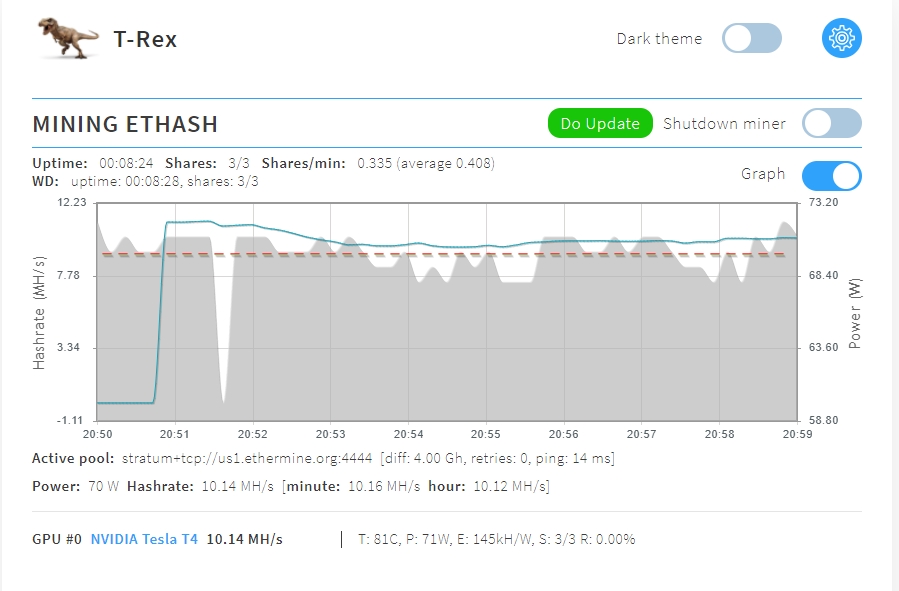Readme
AWS EKS Cluster with GPU instances and miners for Ethereum mining
I'll try out different options and different miners to find a way to make profitable ETH mining.
Benchmarking different instance types and mining clients.
Requirements
awscli v2
eksctl 0.35
kubectl v1.19.1
aws credentials to access AWS account
User profile set properly for setup EKS cluster
Setup EKS cluster
We start from
g4dn.xlarge, change it in 01-cluster.yaml to feet your needsCreate cluster and node group ( 2 instances)
eksctl create cluster -f 01-cluster.yamlAdd created cluster to environment
aws eks update-kubeconfig --name [EKS_CLUSTER_NAME] --region us-east-1Verify nodes are ready to use
kubectl get nodes -o wideUpdate k8s-device-plugin
After GPU nodes join your cluster, you must apply the NVIDIA device plugin for Kubernetes as a DaemonSet on your cluster with the following command.
kubectl apply -f https://raw.githubusercontent.com/NVIDIA/k8s-device-plugin/v0.7.3/nvidia-device-plugin.ymlVerify
kubectl get nodes "-o=custom-columns=NAME:.metadata.name,GPU:.status.allocatable.nvidia\.com/gpu"
NAME GPU
ip-192-168-2-148.ec2.internal 1
ip-192-168-31-129.ec2.internal 1Check if driver installed:
kubectl.exe get pods
NAME READY STATUS RESTARTS AGE
t-rex-5549bfccdb-rbp5d 1/1 Running 0 6h12m
t-rex-5549bfccdb-wnvch 1/1 Running 0 6h12mkubectl exec --stdin --tty t-rex-5549bfccdb-rbp5d -- nvidia-smi
# nvidia-smi
Thu Jan 7 20:37:42 2021
+-----------------------------------------------------------------------------+
| NVIDIA-SMI 450.51.06 Driver Version: 450.51.06 CUDA Version: 11.0 |
|-------------------------------+----------------------+----------------------+
| GPU Name Persistence-M| Bus-Id Disp.A | Volatile Uncorr. ECC |
| Fan Temp Perf Pwr:Usage/Cap| Memory-Usage | GPU-Util Compute M. |
| | | MIG M. |
|===============================+======================+======================|
| 0 Tesla T4 Off | 00000000:00:1E.0 Off | 0 |
| N/A 43C P0 70W / 70W | 4282MiB / 15109MiB | 100% Default |
| | | N/A |
+-------------------------------+----------------------+----------------------+
+-----------------------------------------------------------------------------+
| Processes: |
| GPU GI CI PID Type Process name GPU Memory |
| ID ID Usage |
|=============================================================================|
+-----------------------------------------------------------------------------+Deploy miners
Currently, 2 miners was tested, etherminer and t-rex.
ethminer
Worked with the ethermine.org pool. Deploy the mainer Add to environment following
This worker name will shown on https://ethermine.org/
export WORKER_NAME=ethminer-$HOSTNAME
This is a "Miner Address" on https://ethermine.org/ e.g ERC20 address You get the earning.
export ETH_WALLET=0x1Fa418c70C5f14b21D00c242Bf369A875F129d12
Deploy
cat "ethminer-deployment.yaml" | sed "s/{{WORKER_NAME}}/$WORKER_NAME/g" | sed "s/{{ETH_WALLET}}/$ETH_WALLET/g" | kubectl apply -f -Check log to see all working as expected
kubectl logs ethminer-6888dd59cc-q2z6wRemove
kubectl.exe delete deployment ethminerDeploy t-rex miner
Add to environment following
This is a "Miner Address" on https://ethermine.org/ e.g ERC20 address You get the earning.
export ETH_WALLET=0x1Fa418c70C5f14b21D00c242Bf369A875F129d12
Connect to preferred pull. Chose pool closet to AWS region e.g us-east-1
export POOL=us1.ethermine.org:4444
Deploy
cat "t-rex-deployment.yaml" | sed "s/{{POOL}}/$POOL/g" | sed "s/{{ETH_WALLET}}/$ETH_WALLET/g" | kubectl apply -f -Benchmark
kubectl exec --stdin --tty t-rex-5549bfccdb-rbp5d -- ./t-rex --benchmark -a ethash -o stratum+tcp://$POLL -u $ETH_WALLET -p x -w $HOSTNAME --mt 4 --api-bind-telnet 0 --api-bind-http 0 --cpu-priority 5You can start port forwarding and have nice dashboard:

To test if Scale matter:
kubectl.exe scale deployments ethminer --replicas=12
The profit result's so far:
Spot pricing
https://aws.amazon.com/ec2/spot/pricing/
These are the g- and p- series instances: g2, g3, and g4 types are generalized GPU instance types with additional optimizations for graphics-intensive applications like gaming, p2 and p3 instances are optimized for CUDA and machine learning applications
+---------------+-----------------------------+-------+--------+-----------+-------------------+--------------------+---------+-----------------+------+----------+
| Instance Name | GPUs series | GPUs | vCPUs | RAM (GiB) | GPU Memory (GiB) | Spot Price | Pods | HasRate | Pods | HasRate |
+-----------+---------------------------------+-------+--------+-----------+-------------------+--------------------+---------+-----------------+------+----------+
| g4dn.xlarge | NVIDIA T4 Tensor | 1 | 4 | 16 | | $0.157 per Hour | 1 | ~25 Mh/s | 12 | 7.7 Mh/s |
| g2.2xlarge | NVIDIA GRID K520 (Kepler) | 1 | 8 | 64 | | $0.195 per Hour | 1 | ~2.34 Mh/s | | |
| g3s.xlarge | NVIDIA Tesla M60 | 1 | 4 | 30.5 | 8 | $0.225 per Hour | 1 | ~2.34 Mh/s | | |
| p2.xlarge | NVIDIA K80 | 1 | 4 | 61 | 12 | $0.270 per Hour | 1 | ~2.34 Mh/s | | |
| p3.2xlarge | NVIDIA Tesla V100 | 1 | 8 | 61 | 16 | $0.918 per Hour | | | | |
| g4ad.4xlarge | AMD Radeon Pro V520 | 1 | 16 | 64 | -- | $0.260 per Hour | | | | |
+---------------+-------------------------------------+-------+---------+----------+-------------------+----------------- --+---------+---------+------+----------+ethminer
pod log show 25.51 Mh
t-rex miner
pod log show 25.76Mh/s
pretty much ethermine

Cleanup
eksctl create cluster -f 01-cluster.yamlOr only specific node group:
eksctl delete nodegroup --cluster=cluster-1 --name=gpu --region=us-east-1Docker containers to use
https://hub.docker.com/r/ahtonen/docker-ethminer
Build
git clone https://github.com/ahtonen/ethminer.git
cd ethminer
git submodule update --init --recursive
docker build -t myminer .Optional Upload to AWS ECR
Create ECR registry (if not already done)
aws ecr-public get-login-password --region us-east-1 | docker login --username AWS --password-stdin public.ecr.aws/m4n6i3j0
docker tag myminer:latest public.ecr.aws/m4n6i3j0/myminer:latest
docker push public.ecr.aws/m4n6i3j0/myminer:latestTo Do
Automatic node's scaling
Add pod's autoscaling
Find best performed instance ($/Mhz)
Manage entrypoint in kubernetes config map
Buy me a Coffe
ETH: 0x1Fa418c70C5f14b21D00c242Bf369A875F129d12
Last updated
Was this helpful?